Themed collection Spotlight Collection: Metallocycles and Metallocages

Metallocycles and metallocages
Guest Editors Lin Xu, Cally Haynes and James Lewis introduce the spotlight collection: Metallocycles and metallocages.

Dalton Trans., 2023,52, 8170-8171
https://doi.org/10.1039/D3DT90077K
Precision syntheses of molecular necklaces based on coordination interactions
Precision syntheses and potential applications of molecular necklaces based on coordination interactions.

Dalton Trans., 2023,52, 2915-2923
https://doi.org/10.1039/D2DT03594D
Recent advances in luminescent metallacycles/metallacages for biomedical imaging and cancer therapy
Rational design of luminescent metallacycles/metallacages for advanced biomedical imaging and cancer therapy.

Dalton Trans., 2022,51, 16428-16438
https://doi.org/10.1039/D2DT02766F
Synthesis, characterization, and heparin-binding study of a self-assembled p-cymene-Ru(II) metallocycle based on a 4-amino-1,8-naphthalimide Tröger's base supramolecular scaffold
The synthesis, photophysics, and heparin-binding ability of a [2 + 2] self-assembled Ru(II) metallocycle (TBNap-Ru-MC) based on a green-emitting 4-amino-1,8-naphthalimide Tröger's base (TBNap) are described.

Dalton Trans., 2023,52, 2566-2570
https://doi.org/10.1039/D2DT03079A
The rigidity of self-assembled cofacial porphyrins influences selectivity and kinetics of oxygen reduction electrocatalysis
Cofacial porphyrin prisms are electrocatalysts for the Oxygen Reduction Reaction. When they are structurally rigidified at their metal nodes, their selectivity changes significantly from >95% to 35% despite similar metal–metal separations.
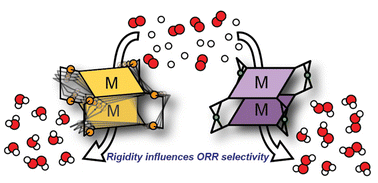
Dalton Trans., 2022,51, 18373-18377
https://doi.org/10.1039/D2DT02724K
Metallacycle-cored fluorescent supramolecular polymer networks for the detection of acidic environments
Despite the challenges, supramolecular polymers (SPs) have received significant attention.
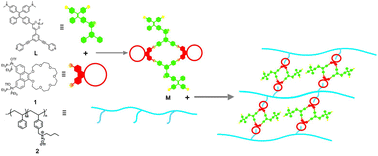
Dalton Trans., 2022,51, 14434-14438
https://doi.org/10.1039/D2DT02783F
Synthesis of a Zr4(embonate)6–cobalt based superstructure for photocatalytic hydrogen production
A novel Zr4(embonate)6–Co based photocatalyst was constructed by a stepwise assembly strategy, and exhibited notable photocatalytic activity for H2 evolution in the absence of a photosensitizer.

Dalton Trans., 2022,51, 11612-11616
https://doi.org/10.1039/D2DT01976K
Encapsulating electron-deficient dyes into metal–organic capsules to achieve high reduction potentials
The host–guest system constructed by incorporating the electron-deficient dyes, anthraquinones, into electron-rich metal–organic capsules has successfully achieved efficient photocatalytic reduction of aryl chlorides via multiphoton excitation.
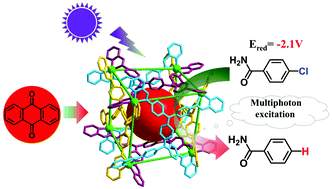
Dalton Trans., 2022,51, 10860-10865
https://doi.org/10.1039/D2DT01166B
A discrete Cu2(Pd-bpy)2L2 heterometallic compound with superoxide dismutase enzyme like activity
An aqueous soluble discrete heterometallic compound consisting of Cu(II) and Pd(II) units with SOD mimicking activity has been demonstrated.
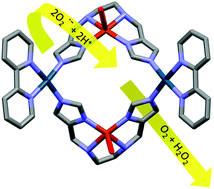
Dalton Trans., 2020,49, 8850-8854
https://doi.org/10.1039/D0DT00920B
Self-assembly of mixed-valence and heterometallic metallocycles: efficient catalysts for the oxidation of alcohols to aldehydes in ambient air
Two mixed-valence CuII/CuI and two heterometallic CuII/AgI metallocycles have been synthesized by the assembly of designed metalloligands and CuI/AgI ions, respectively.
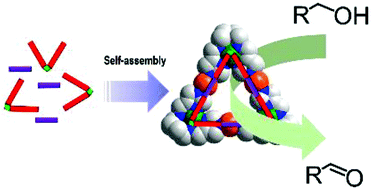
Dalton Trans., 2020,49, 7304-7308
https://doi.org/10.1039/D0DT01340D
A tri-metallic palladium complex with breast cancer stem cell potency
A multi-nuclear, triangular-shaped palladium(II) complex is shown to equipotently kill bulk cancer cells and cancer stem cells (CSCs) in the micromolar range.
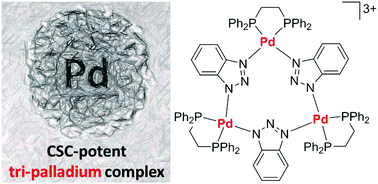
Dalton Trans., 2020,49, 4211-4215
https://doi.org/10.1039/D0DT00006J
A mixed-spin spin-crossover thiozolylimine [Fe4L6]8+ cage
A mixed-spin spin-crossover thiozolylimine [Fe4L6]8+ tetrahedral cage is reported.
![Graphical abstract: A mixed-spin spin-crossover thiozolylimine [Fe4L6]8+ cage](/en/Image/Get?imageInfo.ImageType=GA&imageInfo.ImageIdentifier.ManuscriptID=C9DT01947B&imageInfo.ImageIdentifier.Year=2019)
Dalton Trans., 2019,48, 9935-9938
https://doi.org/10.1039/C9DT01947B
Strongly luminescent 5d/4f heterometal–organic macrocycles with open metal sites: post-assembly modification and sensing
Strongly luminescent 5d/4f heterometal–organic macrocycles featuring open metal sites have been constructed, along with their post-assembly modification and sensing properties.

Dalton Trans., 2019,48, 4479-4483
https://doi.org/10.1039/C9DT00710E
Metal-directed self-assembly of constitutionally dynamic systems: control of the nuclearity of Pd(II)/Pt(II) metallacycles
4,4′-Bipyridinium-based ditopic ligands assemble with Pd(II) centers generating constitutionally dynamic systems in which concentration is a suitable stimulus to influence the speciation between mononuclear [PdL]5+ and dinuclear [Pd2L2]10+ species.

Dalton Trans., 2023,52, 90-96
https://doi.org/10.1039/D2DT02955C
Hydrazone- and imine-containing [PdPtL4]4+ cages: a comparative study of the stability and host–guest chemistry
A new [PdPtL4]4+ heterobimetallic cage containing hydrazone linkages has been synthesised using the sub-component self-assembly approach.
![Graphical abstract: Hydrazone- and imine-containing [PdPtL4]4+ cages: a comparative study of the stability and host–guest chemistry](/en/Image/Get?imageInfo.ImageType=GA&imageInfo.ImageIdentifier.ManuscriptID=D2DT02720H&imageInfo.ImageIdentifier.Year=2022)
Dalton Trans., 2022,51, 18438-18445
https://doi.org/10.1039/D2DT02720H
Crystalline paramagnetic supramolecular 2D-polymer of the tetra(4-pyridyl)porphyrin and terbium(III) complex
A new crystalline hybrid organic–inorganic two-dimensional supramolecular polymer of the tetra(4-pyridyl)porphyrin and terbium(III) complex, TbIII(TMHD)3, has been obtained and investigated.
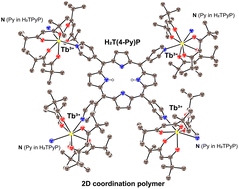
Dalton Trans., 2022,51, 16921-16925
https://doi.org/10.1039/D2DT03170A
cis-Dipyridyl porphyrin-based multicomponent organoplatinum(II) bismetallacycles for photocatalytic oxidation
Three organoplatinum(II) bismetallacycles were prepared with good singlet oxygen generation efficiency, which were used for the photocatalytic oxidation reaction.

Dalton Trans., 2022,51, 16517-16521
https://doi.org/10.1039/D2DT02197H
Diastereoselectively self-sorted low-symmetry binuclear metallomacrocycle and trinuclear metallocage
The complexation of an unsymmetrical bis-monodentate ligand with cis-protected Pd(II) and naked Pd(II) separately resulted in exclusively selevctive isomers of binuclear and trinuclear complexes.

Dalton Trans., 2022,51, 11650-11657
https://doi.org/10.1039/D2DT01571D
Inside or outside the box? Effect of substrate location on coordination-cage based catalysis
The cavity is not everything! Catalysed hydrolysis of 4-nitrophenylacetate is inhibited inside a cage (left), but hydrolysis of diacetylfluorescein (right) is catalysed by the exterior surface.

Dalton Trans., 2022,51, 11277-11285
https://doi.org/10.1039/D2DT01713J
Ruthenium-based assemblies incorporating tetrapyridylporphyrin panels: a photosensitizer delivery strategy for the treatment of rheumatoid arthritis by photodynamic therapy
Ruthenium-based assemblies containing tetrapyridylporphyrin derivatives in their structures have been evaluated as photosensitizers to treat rheumatoid arthritis by photodynamic therapy.
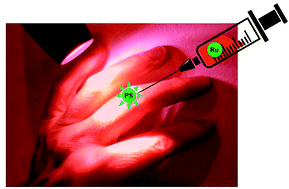
Dalton Trans., 2022,51, 9673-9680
https://doi.org/10.1039/D2DT00917J
Supramolecular-controlled regioselective photochemical [4 + 4] cycloaddition within Cp*Rh-based metallarectangles
A regioselective and reversible photochemical [4 + 4] cycloaddition was achieved within supramolecular metallarectangles with the assistance of a Cp*Rh-based organometallic template.
![Graphical abstract: Supramolecular-controlled regioselective photochemical [4 + 4] cycloaddition within Cp*Rh-based metallarectangles](/en/Image/Get?imageInfo.ImageType=GA&imageInfo.ImageIdentifier.ManuscriptID=D2DT01094A&imageInfo.ImageIdentifier.Year=2022)
Dalton Trans., 2022,51, 8743-8748
https://doi.org/10.1039/D2DT01094A
Highly-fluorescent BODIPY-functionalised metallacages as drug delivery systems: synthesis, characterisation and cellular accumulation studies
Self-assembled [Pd2L4]4+ metallacages are promising novel drug delivery systems for anticancer drugs. Their exo-functionalisation with BODIPY moieties enabled the investigation of their uptake mechanisms in cancer cells by confocal microscopy.

Dalton Trans., 2022,51, 7476-7490
https://doi.org/10.1039/D2DT00337F
Coordination-driven self-assembly of anthraquinone-based metal–organic cages for photocatalytic selective [2 + 2] cycloaddition
Guided by the coordination-driven self-assembly, four metal–organic cages (MOCs) with D2 or D4h symmetry are synthesized and can be efficient catalysts for photocatalytic [2 + 2] cycloaddition reaction.
![Graphical abstract: Coordination-driven self-assembly of anthraquinone-based metal–organic cages for photocatalytic selective [2 + 2] cycloaddition](/en/Image/Get?imageInfo.ImageType=GA&imageInfo.ImageIdentifier.ManuscriptID=D1DT00652E&imageInfo.ImageIdentifier.Year=2021)
Dalton Trans., 2021,50, 8533-8539
https://doi.org/10.1039/D1DT00652E
Coordination-driven discrete metallo-supramolecular assembly for rapid and selective photochemical CO2 reduction in aqueous solution
A discrete metallo-supramolecular assembly bearing six iron(II) centers and twelve terpyridine fragments has been developed for highly efficient and selective photochemical CO2 reduction with an organic TADF photosensitizer.

Dalton Trans., 2021,50, 6273-6280
https://doi.org/10.1039/D1DT00692D
Preparation of a magnetic metal–organic square and metal–organic cubes using 4,5-bis(2-imidazolinyl)imidazolate: slow magnetization relaxation behavior in mixed-valent octamanganese(II/III) clusters
Functional metal–organic squares (MOSs) and metal–organic cubes (MOCs) are important building units for zeolite-like metal–organic frameworks (ZMOFs), which are required to exhibit solid-state properties, such as dielectric and magnetic properties.
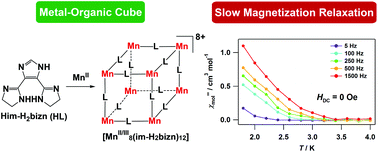
Dalton Trans., 2021,50, 5452-5464
https://doi.org/10.1039/D0DT04425C
A green separation process of Ag via a Ti4(embonate)6 cage
A green supramolecular recovery process of Ag has been developed by using a highly charged anionic Ti4L6 (L = embonate) cage as the extractant.
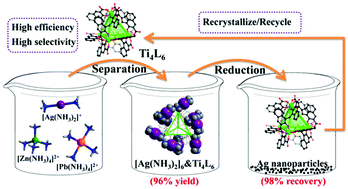
Dalton Trans., 2020,49, 17194-17199
https://doi.org/10.1039/D0DT03214J
Flexibility and anion exchange of [(X)@Pd2L4] cages for recognition of size and charge of polyatomic anions
A system of a Pd2L4 coordination cage was constructed, and the cage is an efficient gauge for the recognition of ubiquitous polyatomic anions.
![Graphical abstract: Flexibility and anion exchange of [(X)@Pd2L4] cages for recognition of size and charge of polyatomic anions](/en/Image/Get?imageInfo.ImageType=GA&imageInfo.ImageIdentifier.ManuscriptID=D0DT03005H&imageInfo.ImageIdentifier.Year=2020)
Dalton Trans., 2020,49, 15002-15008
https://doi.org/10.1039/D0DT03005H
Substrate and product binding inside a stimuli-responsive coordination cage acting as a singlet oxygen photosensitizer
Multiple functionalities of an acridone-based metallosupramolecular assembly: photosensitization of singlet oxygen, allosteric activation as host and encapsulation of the substrate and product of a hetero-Diels-Alder reaction.
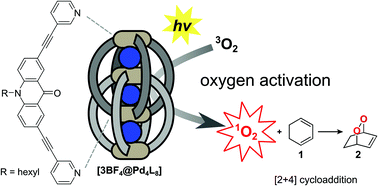
Dalton Trans., 2020,49, 9404-9410
https://doi.org/10.1039/D0DT01674H
On/off fluorescence emission induced by encapsulation, exchange and reversible encapsulation of a BODIPY-guest in self-assembled organometallic cages
A reversible fluorescence turn off/on switch induced by the encapsulation and release of a guest molecule within an organometallic cage was presented.
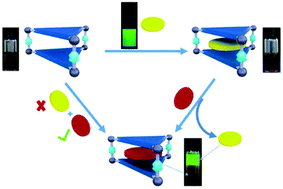
Dalton Trans., 2019,48, 7236-7241
https://doi.org/10.1039/C8DT05103H
Self-assembly processes of octahedron-shaped Pd6L12 cages
Self-assembly processes of three octahedron-shaped [Pd6L12]12+ cages were investigated by an NMR-based quantitative approach (QASAP).
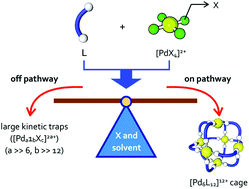
Dalton Trans., 2019,48, 4139-4148
https://doi.org/10.1039/C8DT04931A
About this collection
Metallocycles and Metallocages are discrete, 2D and 3D metal-organic architectures. These beautiful and often complex structures can be formed from relatively simple building blocks through self-assembly processes centred around transition metal and lanthanide coordination chemistry. The diversity of accessible topologies and sizes, combined with their well-defined cavities, make them fascinating synthetic targets and attractive hosts in supramolecular chemistry. This Spotlight Collection aims to celebrate recent developments in the field, highlighting both fundamental and applied research.
Fundamental research into the construction and structural interconversion of new cages and metallocycles remains a valuable and popular research topic, while new and varied applications of these structures continue to develop and expand. Examples found within this collection include studies of spin and magnetism, hierarchical self-assembly into gels and applications in catalysis, separations, cancer therapeutics and optical detection.
This collection is guest edited by Dalton Transactions Advisory Board member Prof. Lin Xu (East China Normal University), alongside Dr Cally Haynes (University College London) and Dr James Lewis (Imperial College London).
Articles will be added to this themed collection as soon as possible after they are published. Please return to this page frequently to see the collection grow.
If you would like to contribute an article to this collection, please contact the Editorial Office at dalton-rsc@rsc.org with your proposed topic.